
Here you can study for the exam. Look up keywords and learn definitions about all kind of subjects.
More subjects
The AC 3000ME is a mid-engined sports car originally sold by AC Cars. The two-door coupé debuted at the 1973 London Motor Show. Sales did not begin until 1979 and lasted until 1984. Rights to the 3000ME and tooling were transferred to a second company who managed to produce a small number of additional cars before going into receivership themselves in mid-1985. A third company acquired the rights to the car with plans to begin selling a revised version under a different name, but only a single prototype was ever produced. (Source: Wikipedia.org, CC BY-SA)
The AC Frua or AC 428 is a British GT built by AC Cars from 1965 to 1973. Production was 81 cars built in total: 49 coupés (known as fastbacks), 29 convertibles, and 3 special bodied. The Frua is built on an AC Cobra 427 Mark III chassis extended by 6 inches (150 mm). Chassis were built at the AC plant in England then shipped to Frua's workshop in Italy where the body was fitted and then sent back to England to have the power train and trim added. The cost was high and the cars could not be sold at a competitive price. Unlike similar cars such as the Iso Grifo, Iso Rivolta, Monteverdi, and De Tomaso models of the period, the AC Frua features fully independent racing based coil spring suspension. (Source: Wikipedia.org, CC BY-SA)
The AC Cobra, sold in the United States as the Shelby Cobra and AC Shelby Cobra, is a sports car manufactured by British company AC Cars, with a Ford V8 engine. It was produced intermittently in both the United Kingdom and later the United States since 1962. Like many British manufacturers, AC Cars had been using the Bristol straight-6 engine in its small-volume production, including its AC Ace two-seater roadster. This had a hand-built body with a steel tube frame, and aluminium body panels that were made using English wheeling machines. The engine was a pre-World War II design by BMW which by the 1960s was considered dated. In 1961 Bristol decided to cease production of its engine. (Source: Wikipedia.org, CC BY-SA)
The AMC Gremlin (also American Motors Gremlin) is a subcompact automobile introduced in 1970, manufactured and marketed in a single, two-door body style (1970–1978) by American Motors Corporation (AMC), as well as in Mexico (1974–1983) by AMC's Vehículos Automotores Mexicanos (VAM) subsidiary. Using a shortened Hornet platform and bodywork with a pronounced kammback tail, the Gremlin was classified as an economy car and competed with the Chevrolet Vega and Ford Pinto, as well as imported cars including the Volkswagen Beetle and Toyota Corolla. The small domestic automaker marketed the Gremlin as 'the first American-built import.' The Gremlin reached a total production of 671,475 over a single generation. It was superseded by a restyled and revised variant, the AMC Spirit produced from 1979 through 1983. This was long after the retirement of the Ford Pinto that suffered from stories about exploding gas tanks, as well as the Chevrolet Vega with its rusting bodies and durability problems with its aluminum engine. (Source: Wikipedia.org, CC BY-SA)
The AMC Hornet is a compact automobile manufactured and marketed by American Motors Corporation (AMC) and made from 1970 through 1977 — in two- and four-door sedan, station wagon, and hatchback coupe configurations. The Hornet replaced the compact Rambler American line, marking the end of the Rambler marque in the American and Canadian markets. Hornets were marketed in foreign markets and were assembled under license agreements between AMC — for example, with Vehículos Automotores Mexicanos (VAM), Australian Motor Industries (AMI), and by Toyota S.A. Ltd. in South Africa. The Hornet became important for the automaker in being a top seller during its production as well as a car platform serving the company in varying forms through the 1988 model year. Introduced in 1969, AMC earned a high rate return for its development investment for the Hornet. The platform became the basis for AMC's subcompact Gremlin, luxury compact Concord, liftback and sedan Spirit, and the innovative all-wheel drive AMC Eagle. It would also outlast the compact platforms from the competition, including the Chevrolet Nova, Ford Maverick, and Plymouth Valiant. (Source: Wikipedia.org, CC BY-SA)
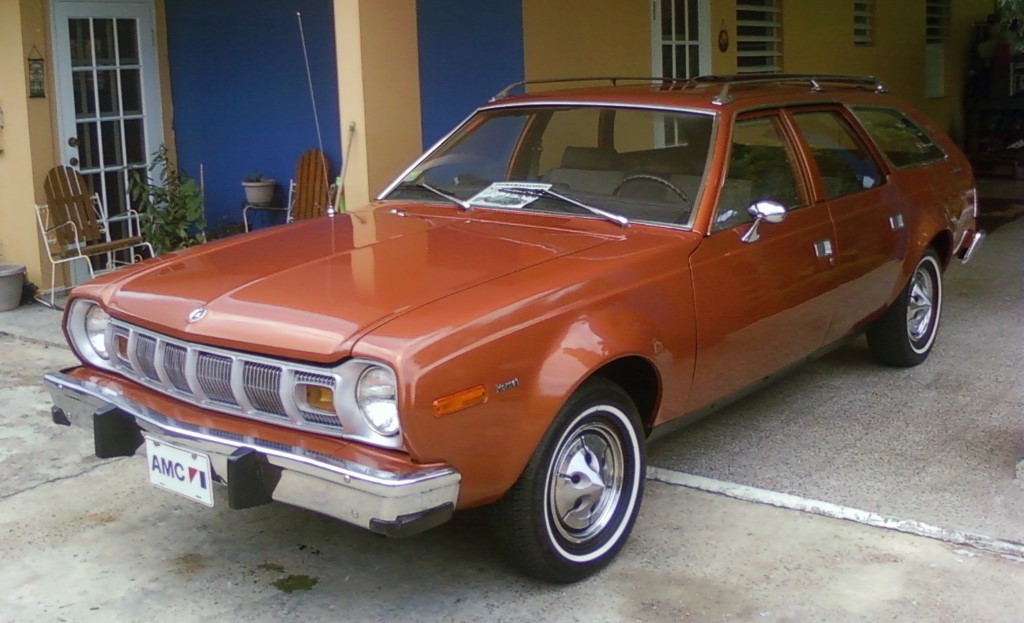 © Wikimedia.org/Denam Rivera, CC BY-SA
© Wikimedia.org/Denam Rivera, CC BY-SA
The Acura ILX is a compact car (C-segment) manufactured and marketed by Honda under the Acura brand, based on the ninth-generation Civic sedan. The ILX replaced the Canadian market exclusive Acura CSX. The gasoline-electric hybrid version was Acura's first. The concept version was unveiled at the 2012 North American International Auto Show, the production version was presented in the 2012 Chicago Auto Show. The ILX introduces a new design that Acura calls 'aero-fused dynamics'. Mass production commenced on April 23 at Honda's assembly facility in Greensburg, Indiana and U.S. sales began on May 22. (Source: Wikipedia.org, CC BY-SA)
The Acura Legend is a mid-size luxury/executive car manufactured by Honda from Japan. It was sold in the U.S. and Canada under Honda's luxury brand, Acura, from 1985 until 1995 as both a sedan, which was classified as a full-size car, and a coupe, which was classified as a mid-size car (similar to how the Honda Accord is set up today). It was the first flagship sedan sold under the Acura nameplate, until being renamed in 1996 as the Acura 3.5RL. The 3.5RL was the North American version of the KA9 series Honda Legend. The opportunity for Japanese manufacturers to export more expensive models had arisen with the 1980s voluntary export restraints, negotiated by the Japanese government and U.S. trade representatives, restricting mainstream car sales. The initial success of the Legend and Honda's Acura division in competing against established European and American luxury manufacturers would lead to Toyota and Nissan creating the Lexus and Infiniti brands, respectively, to compete in the luxury car market. (Source: Wikipedia.org, CC BY-SA)
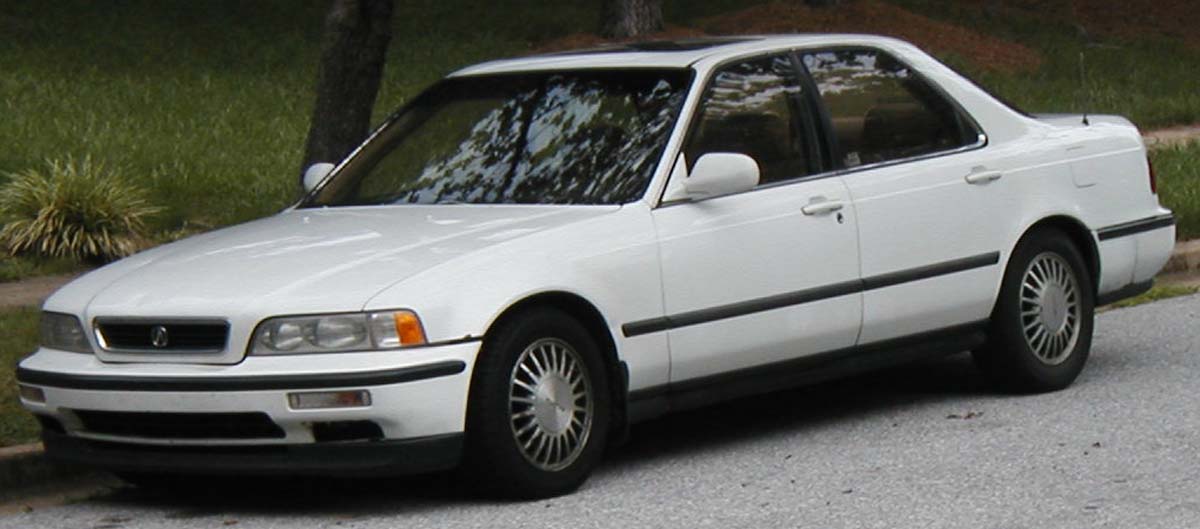 © Wikimedia.org/IFCAR, CC0
© Wikimedia.org/IFCAR, CC0
The Acura MDX is a mid-size luxury crossover SUV with three-row seating produced by the Japanese automaker Honda under its luxury Acura division since 2000. The alphanumeric moniker stands for 'Multi-Dimensional' luxury. It has ranked as the second-best selling mid-size luxury SUV after the Lexus RX. The MDX is the first luxury crossover SUV to have standard third-row seating, and shares its platform with the Honda Pilot. The Pilot was made available with an eight person seating configuration, while the MDX exclusively seats seven, with two seating positions in the third row. The MDX was introduced on October 5, 2000 as a 2001 model, replacing the slow-selling U.S.-only body-on-frame SLX, based on the Isuzu Trooper. In Japan, it was made to replace the Honda Horizon (also based on the Trooper) which was discontinued in 1999. In 2003, the vehicle went on sale in Japan and Australia as the Honda MDX; sales with Honda badges ended with the introduction of the second generation three years later. (Source: Wikipedia.org, CC BY-SA)
The Acura RDX is a compact luxury crossover SUV produced by Acura, a luxury vehicle division of Honda, as the second crossover SUV offering from the brand after the mid-size MDX. Initially sharing its platform with the Honda Civic and CR-V, with the third generation, the RDX uses its own platform. Originally previewed as the Acura RD-X concept car, the production RDX had its debut at the 2006 New York Auto Show and went on sale on August 11, 2006. A facelifted 2010 model went on sale in August 2009, which featured the addition Acura's 'power plenum' grille and a front-wheel drive option. (Source: Wikipedia.org, CC BY-SA)
The Acura RL is a mid-size luxury car that was manufactured by the Acura division of Honda for the 1996–2012 model years over two generations. The RL was the flagship of the marque, having succeeded the Acura Legend, and was replaced in 2013 by the Acura RLX. All models of the Legend, RL and RLX lines have been adapted from the Japanese domestic market Honda Legend. The model name 'RL' is an abbreviation for 'Refined Luxury.' The first-generation Acura RL was a rebadged version of the third-generation Honda Legend, and was first introduced to the North American market in 1996, to replace the second-generation Acura Legend. The second-generation Acura RL was a rebadged version of the fourth-generation Honda Legend, introduced to the North American market in September 2004, as a 2005 model. This iteration of the RL received an extensive mid-generational facelift for the 2009 model year, and a further update for 2011. The third-generation debuted for the 2014 model year as the Acura RLX. (Source: Wikipedia.org, CC BY-SA)
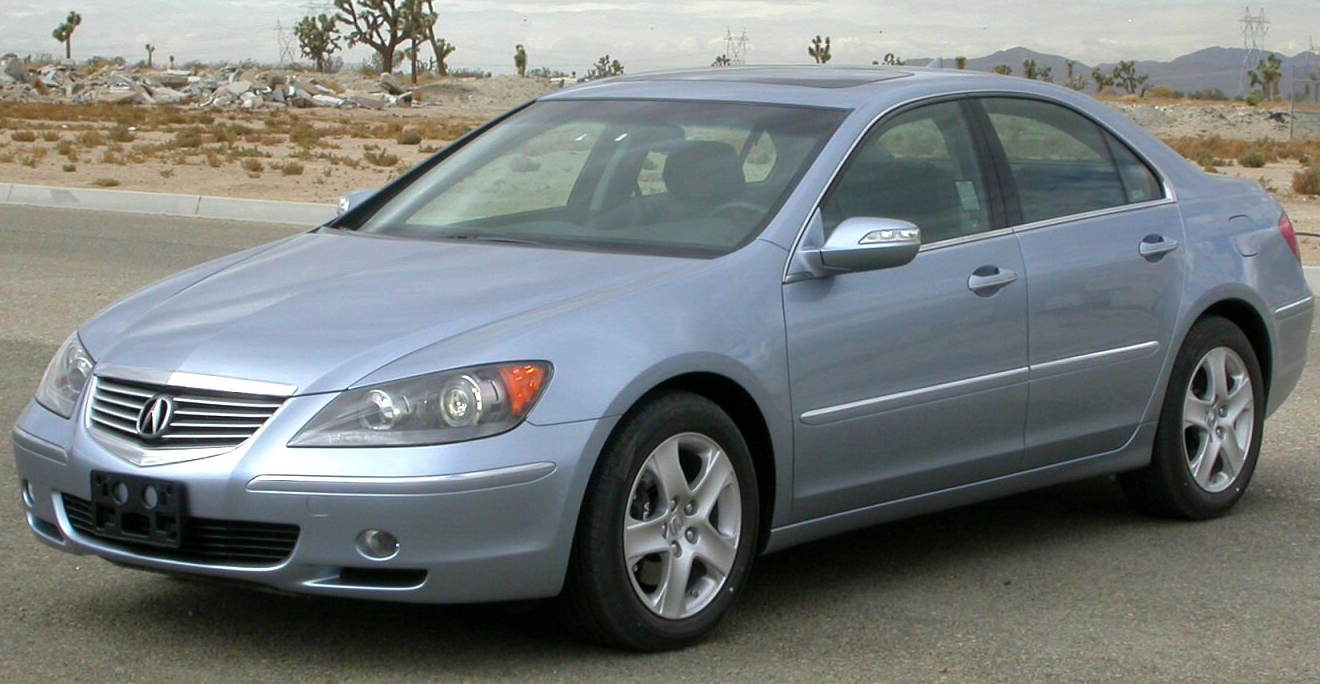 © Wikimedia.org/U.S. National Highway Traffic Safety Administration, CC0
© Wikimedia.org/U.S. National Highway Traffic Safety Administration, CC0
The Acura TL is an executive car that was manufactured by Acura, the luxury division of Honda. It was introduced in 1995 to replace the Acura Vigor and was badged for the Japanese-market from 1996 to 2000 as the Honda Inspire and from 1996 to 2004 as the Honda Saber. The TL was Acura's best-selling model until it was outsold by the MDX in 2007. In 2005, it ranked as the second best-selling luxury sedan in the United States behind the BMW 3 Series, but sales decreased after the 2008 model year. Four generations of the Acura TL were produced, with the final fourth generation TL premiering in 2008 as a 2009 model and ending production in 2014, when it was replaced together with the TSX by the TLX. (Source: Wikipedia.org, CC BY-SA)
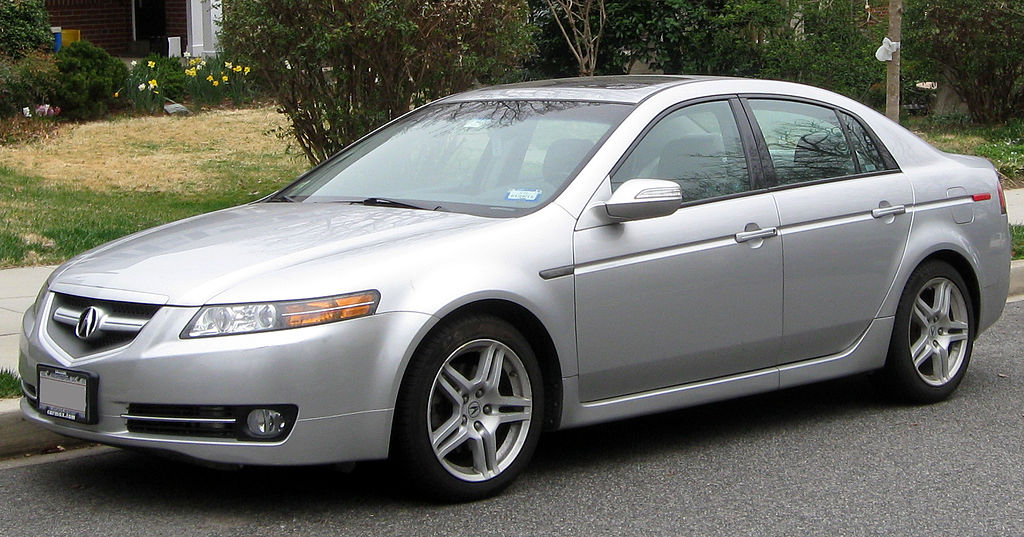 © Wikimedia.org/IFCAR, CC0
© Wikimedia.org/IFCAR, CC0
The Acura TSX is a compact executive car manufactured by Honda and sold through its Acura division from 2003 to 2014. The TSX spanned two generations, both derived from the corresponding Japanese/European versions of the Honda Accord, which were more compact and sporting-oriented than its larger North American counterpart, the latter platform which also used for the Acura TL which slotted above the TSX in Acura's lineup. All TSXs were built in Sayama, Saitama, Japan. The first-generation TSX was introduced as a 2004 model in April 2003 as a rebadged version of the Japanese domestic market (JDM) Honda Accord 2.4 Type-S, with the exception of its interior, borrowed from the JDM fourth-generation Honda Inspire. It was succeeded by the second-generation TSX, introduced in March 2008 as a 2009 model and based on the eighth-generation JDM Accord. Notably, the final generation of the TSX would introduce a V6 option for 2010, and a wagon for 2011. (Source: Wikipedia.org, CC BY-SA)
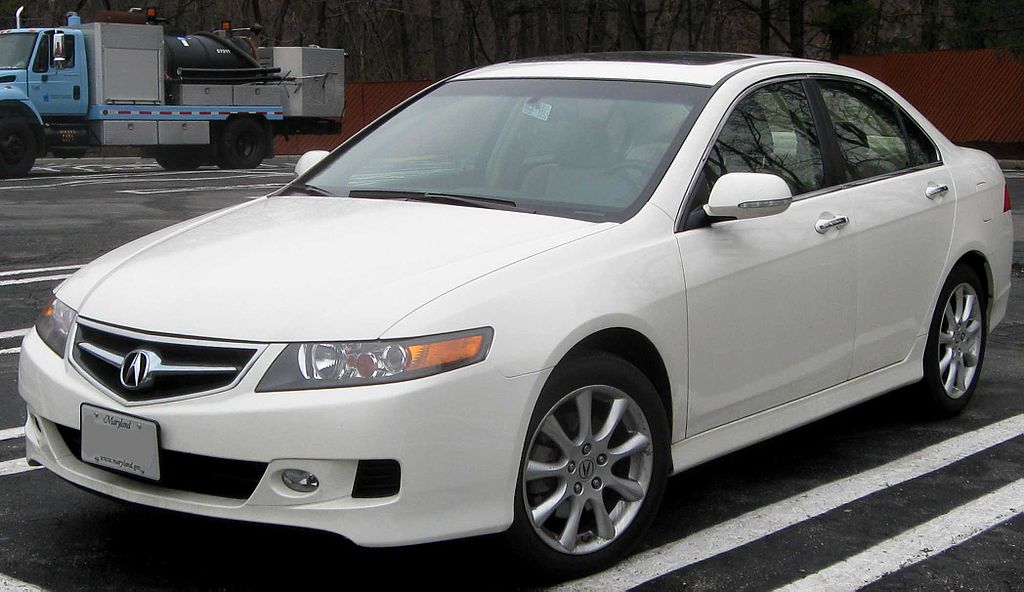 © Wikimedia.org/IFCAR, CC0
© Wikimedia.org/IFCAR, CC0
The Acura ZDX is a mid-size luxury crossover SUV with a sloping rear roofline developed by Honda for its upmarket brand Acura. The car was originally planned to be called the 'MSX'. The ZDX debuted at the 2009 New York International Auto Show on April 8, 2009, as a 2010 model. The vehicle was also the first to be completely designed at Acura's southern California design studio in Torrance. The original ZDX concept was penned by Michelle Christensen who labeled it a '4-door luxury sports coupe' and which Acura says 'blurs the distinction between coupe, sedan and sport utility vehicle.' The ZDX features Acura's first six speed automatic transmission, advanced ventilated seats, as well as other luxury appointments. Although the ZDX shares a similar profile with the Honda Crosstour, the two vehicles are not mechanically related: the latter is based on the Honda Accord, while the ZDX is based on the Honda Pilot/Acura MDX. (Source: Wikipedia.org, CC BY-SA)
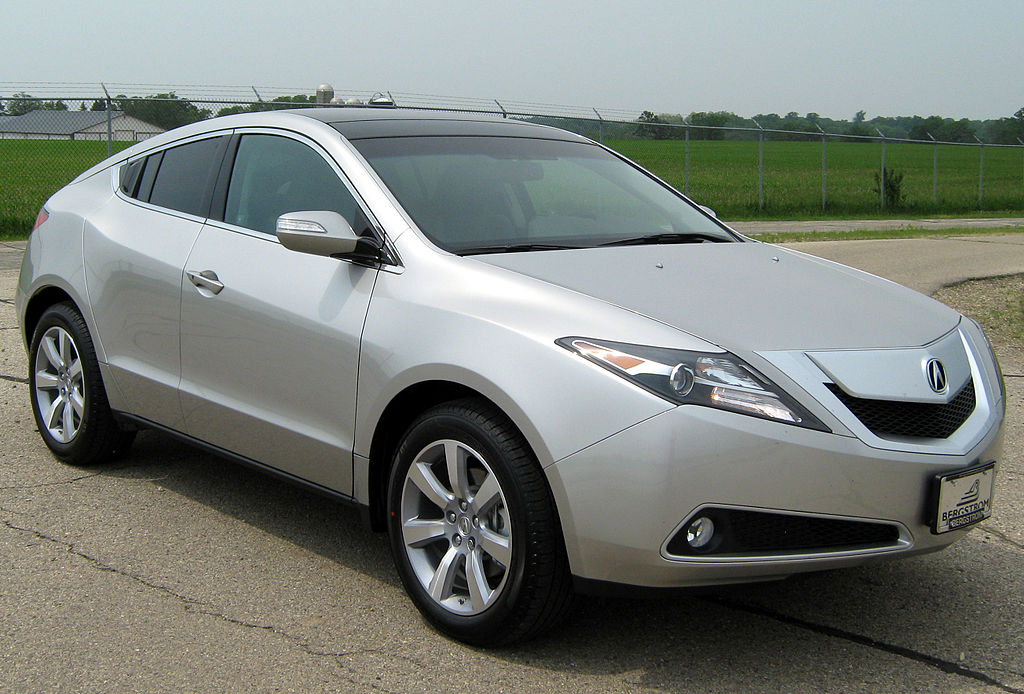 © Wikimedia.org/U.S. National Highway Traffic Safety Administration, CC0
© Wikimedia.org/U.S. National Highway Traffic Safety Administration, CC0
The Alfa Romeo 155 (Type 167) is a compact executive car produced by Italian automobile manufacturer Alfa Romeo between 1992 and 1998. It was unveiled in January 1992 at Barcelona, with the first public launch in March 1992, at the Geneva Motor Show. A total of 195,526 units were made before it was replaced by the 156. Developed to replace the 75 and based on the parent company Fiat Group's Type Three platform, the 155 was somewhat larger in dimension than the 75 and had evolved styling from that of its predecessor. The 155 was designed by Italian design house I.DE.A Institute. An exceptional drag coefficient of 0.29 was achieved with the body design. The boxy design of the 155 allowed for a big boot space 525 L (115 imp gal; 139 US gal). (Source: Wikipedia.org, CC BY-SA)
The Alfa Romeo 156 (Type 932) is a compact executive car produced by the Italian automobile manufacturer Alfa Romeo. It was introduced at the 1997 Frankfurt Motor Show as the replacement for the Alfa Romeo 155. The 156 received a positive reception and in the following year went on to win the 1998 European Car of the Year award. The 156 saloon was discontinued in Europe late in 2005, while the Q4 Crosswagon continued in production until the end of 2007. Cars were assembled at the Fiat Group factory in Pomigliano d'Arco, Italy and at a General Motors facility in Rayong, Thailand. Production in Thailand began in March 2002 and ran for only a couple of years. The cars produced there were targeted for the Asia-Pacific markets. Between 1996 and 2007, 673,435 units of the 156 were produced. (Source: Wikipedia.org, CC BY-SA)
The Alfa Romeo 33 (Type 905 and 907) is a small family car produced by the Italian automaker Alfa Romeo between 1983 and 1995. From a mechanical standpoint it was essentially an evolution of its predecessor, the Alfasud, whose floorpan, chassis and drivetrain were carried over—albeit with modifications to the suspension and braking system. The Nissan-based Alfa Romeo Arna was launched shortly after, offering a similarly sized but lower priced car. The 33 has a unique place in the Alfa Romeo history, as nearly 1 million of these cars were produced. During its 11-year lifespan the 33 saw a light facelift in 1986 and a significant restyle in 1989. The 33 was discontinued in 1994 and replaced by the Alfa Romeo 145 and 146, which used the same boxer engines but built around an entirely new platform based on the Fiat Tipo. (Source: Wikipedia.org, CC BY-SA)
 © Wikimedia.org/Mario.Zelaschi, CC BY-SA
© Wikimedia.org/Mario.Zelaschi, CC BY-SA
The Alfa Romeo 33 Stradale is a mid-engined sports car built by Italian car manufacturer Alfa Romeo. It is one of the world's first supercars; it was the fastest commercially available car for the standing kilometer when introduced. 18 examples were produced between 1967 and 1969. 'Stradale' (Italian for 'road-going') is a term often used by Italian car manufacturers to indicate a street-legal version of a racing car; indeed the 33 Stradale was derived from the Tipo 33 sports prototype. A twin headlight 33 Stradale can be seen in the 1969 Italian movie Un bellissimo novembre. (Source: Wikipedia.org, CC BY-SA)
The Alfa Romeo 75 (Type 161, 162B), sold in North America as the Milano, is a compact executive car produced by the Italian automaker Alfa Romeo between 1985 and 1992. The Alfa 75 was commercially quite successful: in only three years, 236,907 cars were produced, and by the end of production in 1992, around 386,767 had been built. The Alfa Romeo 75 was the last model released before Alfa Romeo was acquired by Fiat. (The Alfa Romeo 164 was the last model developed independently.) The 75 was introduced in May 1985 to replace the Giulietta (with which it shared many components), and was named to celebrate Alfa's 75th year of production. The body, designed by head of Centro Stile Alfa Romeo Ermanno Cressoni, was styled in a striking wedge shape, tapering at the front with square headlights and a matching grille (similar features were applied to the Cressoni-designed 33). (Source: Wikipedia.org, CC BY-SA)
The Alfa Romeo Alfasud (Type 901, 902 and 904) is a small family car manufactured and marketed from 1971 to 1989 by Alfa Romeo as a front-engine, four-door, five-passenger entry-level model over a single generation — with facelifts in 1977 and 1980. There was also a two-door sedan, only available in 'ti' trim. Alfa Romeo subsequently introduced a three-door wagon variant, the Giardinetta (1975); two-door coupé, the Alfasud Sprint (1976); three-door hatchback (1981) and finally the five-door hatchback (1982). Assembly was primarily at the Alfa Romeo Pomigliano d'Arco plant, and 893,719 were manufactured from 1972 to 1983, with the addition of 121,434 Sprint coupé versions between 1976 and 1989. Developed by Austrian engineer, Rudolf Hruska, the Alfasud was noted for its boxer engine configuration, low center of gravity, aerodynamic profile, class-leading handling, styling by Giorgetto Giugiaro of ItalDesign, and a conspicuous susceptibility to rust. (Source: Wikipedia.org, CC BY-SA)
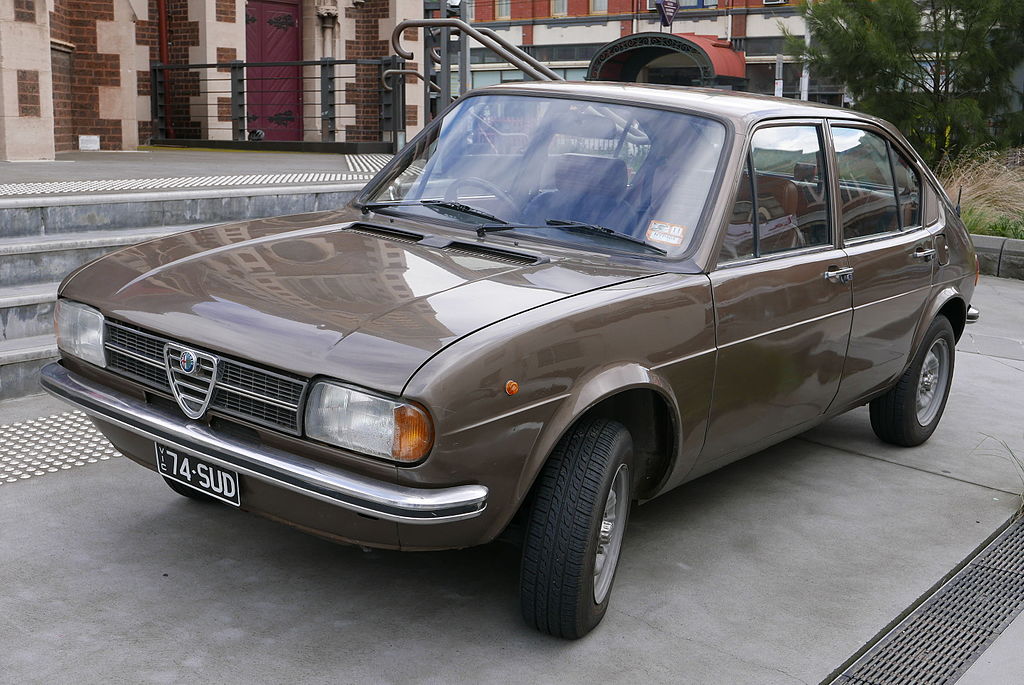 © Wikimedia.org/OSX, CC0
© Wikimedia.org/OSX, CC0
The Alfa Romeo Arna (an acronym for 'Alfa Romeo Nissan Autoveicoli', meaning 'Alfa Romeo[-]Nissan motor vehicles', but also a female Italian name) (Type 920) is a hatchback produced by the Italian manufacturer Alfa Romeo Nissan Autoveicoli S.p.A. between 1983 and 1987. The company was founded on 9 October 1980, as a 50:50 joint venture between the Italian Alfa Romeo S.p.A. and the Japanese Nissan Motor Company. On 9 October 1980, Takashi Ishihara of Nissan and Alfa Romeo President Ettore Massacesi signed a memorandum in Tokyo for increased cooperation between their two firms, and revealed their intent to create a joint production venture called AR.N.A. S.p.A. (Alfa Romeo Nissan Autoveicoli). Italian Prime Minister Francesco Cossiga endorsed the deal, despite political and auto industry opposition, because he hoped to bolster the fortunes of the state owned manufacturer, which had a cult following but was losing money. (Source: Wikipedia.org, CC BY-SA)
The Alfa Romeo Brera and the Alfa Romeo Spider (Type 939) are mid-size sports cars using the GM/Fiat Premium platform, manufactured by Pininfarina and marketed by Alfa Romeo as a 2+2 coupé and roadster respectively. 12,488 units of the Spider and 21,786 units of the Brera were made with production ending in late 2010 and inventory remaining into 2011. The Brera was originally unveiled as a concept car at the 2002 Geneva Motor Show, designed by Giorgetto Giugiaro of Italdesign Giugiaro. The concept was powered by a Maserati V8 engine rated at around 400 PS (294 kW; 395 hp). The Brera received positive feedback, and Alfa Romeo subsequently announced production plans for 2005. In 2004, Giorgetto Giugiaro was awarded the Compasso d'Oro industrial design award for his Brera Concept. (Source: Wikipedia.org, CC BY-SA)
The Alfa Romeo GT (Type 937) is a coupe automobile that was produced by the Italian automaker Alfa Romeo between 2003 and 2010. The GT was introduced in March 2003 at the Geneva Motor Show. Production commenced on 28 November 2003, the GT was built at the Pomigliano plant, alongside the 147 and 159. A total of 80,832 units were produced. The GT was based on Fiat C-platform (also used for the 156) with styling by Bertone. Initially, Bertone insisted to assemble the car at their own plant but after refusal from Alfa Romeo's parent company Fiat, the GT was assembled at the Pomigliano plant instead. (Source: Wikipedia.org, CC BY-SA)
Alfa Romeo Giulia (Italian pronunciation: [ˈdʒuːlja]) is the name of three not directly related models by the Italian car manufacturer Alfa Romeo. The first is a line of sporty four-door compact executive cars (Type 105) produced from 1962 to 1978, the second is an updated, mainly up-engined Spider, Sprint and Sprint Speciale Giuliettas, and the third Giulia is a compact executive car (type 952) unveiled in 2015. Alfa Romeo was one of the first mainstream manufacturers to put a powerful engine in a light-weight 1 tonne (2,205 lb) four-door car for mass production. The Type 105 Giulia was equipped with a light alloy twin overhead camshaft four-cylinder engine similar to that of the earlier Giulietta (750/101) range, available in 1.3-litre (1,290 cc) and 1.6-litre (1,570 cc) versions. Various configurations of carburetors and tuning produced power outputs from about 80 to about 110 bhp (55 to 75 kW), coupled in most cases to 5-speed manual transmission. (Source: Wikipedia.org, CC BY-SA)
The Alfa Romeo Montreal is a 2+2 coupé sports car produced by the Italian manufacturer Alfa Romeo from 1970 to 1977. The Alfa Romeo Montreal was introduced as a concept car in 1967 at Expo 67, held in Montreal, Quebec, Canada. Originally, the concept cars were displayed without any model name, but the public took to calling it The Montreal. It was a 2+2 coupe using the 1.6-litre engine of the Alfa Romeo Giulia TI and the short wheelbase chassis of the Alfa Romeo Giulia Sprint GT, with a body designed by Marcello Gandini at Bertone. One of the two concept cars built for Expo 67 is displayed in the Alfa Romeo Historical Museum in Arese, Italy, while the other is in museum storage. (Source: Wikipedia.org, CC BY-SA)
The Alfa Romeo SZ (Sprint Zagato) or ES-30 (Experimental Sportscar 3.0 litre) is a high-performance limited-production sports car built between 1989 and 1991 by a partnership between Centro Stile Zagato, Centro Stile Alfa Romeo and Centro Stile Fiat. It was unveiled as the ES-30 at the 1989 Geneva Motor Show as a prototype by Zagato, although the car was mainly built by them - not designed mechanically. (Source: Wikipedia.org, CC BY-SA)
The Alfa Romeo Spider (105/115 series) is a two-seater, front-engined, rear-drive roadster manufactured and marketed by Alfa Romeo from 1966 to 1994 in four distinct generations, or 'series', each with modifications ranging from modest to extensive. As successor to the Giulia Spider, the Spider remained in production for almost three decades. The first three series were assembled by Pininfarina in Grugliasco and the fourth series in San Giorgio Canavese. The last Spider of that series was manufactured in April 1993 — the last rear-wheel drive Alfa Romeo before the Alfa Romeo 8C Competizione of 2007. In 2012, FCA Italy and Mazda studied the possibility of jointly developing a new Spider for 2015 based on the Mazda MX-5 platform. Ultimately, FCA and Mazda chose to manufacture a modern interpretation of the Fiat 124 Sport Spider rather than reviving the Alfa Romeo Spider. (Source: Wikipedia.org, CC BY-SA)
The Alpine A106 was the first of a line of light-weight glass-fibre bodied, rear-engined two-door coupés produced for a young competition-oriented Dieppe based Renault dealer called Jean Rédélé. The car was based on mechanical components from the Renault 4CV. The car was inspired by the “Marquis” a Renault 4CV based coupé, a design acquired for production under licence in the United States but which had never entered production. More direct inspiration came from the “Allemano”, another Renault 4CV based coupé prototype, and modified by Chappe et Gessalin, the firm that would assemble the early “glass fibre” bodied A106s for Alpine. Under the skin, the A106 closely resembled the 4CV. The more sporting 43 hp (32 kW) “A106 Mille Miles” would derive from a competition version of the 4CV model developed by Renault. (Source: Wikipedia.org, CC BY-SA)
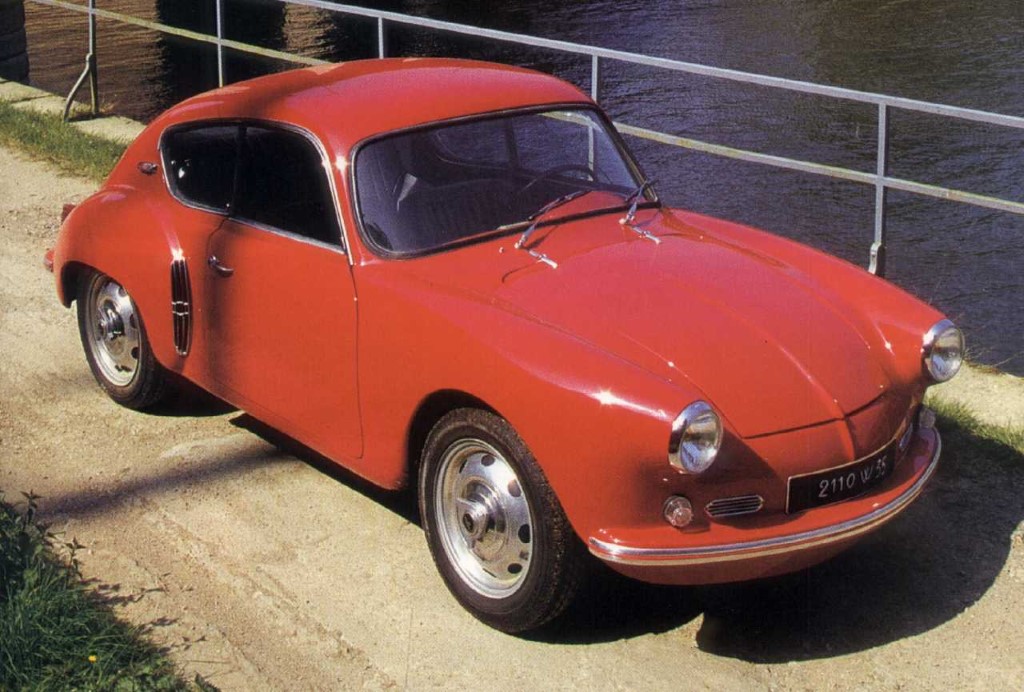 © Wikimedia.org/X-Ray91270, CC0
© Wikimedia.org/X-Ray91270, CC0
The Alpine A108 was a light-weight glass-fibre bodied, rear-engined two-door coupé produced for a young competition-oriented Dieppe based Renault dealer called Jean Rédélé. The car replaced the Alpine A106 and was based on mechanical components from the Renault Dauphine. The Alpine 106 had taken its name from the first three digits of the four-digit homologation number of the old Renault 4CV on which the car was based. Applying the same logic, the new car should have been called 109 because it used mechanical components from the newer Renault Dauphine which was registered under the French homologation number 1090, but instead the new car, which inherited many of its non-mechanical components from the 106, was given the name Alpine 108. In this form, where the 106 had used an engine from the Renault 4CV, the new model, as launched in 1957, used the Gordini version of the 845 cc engine fitted in the Dauphine. (Source: Wikipedia.org, CC BY-SA)
The Alpine A110 is a sports car produced by French automobile manufacturer Alpine from 1963 to 1977. The car was styled as a 'berlinette', which in the post-WWII era refers to a small enclosed two-door berline, better-known as a coupé. The Alpine A110 succeeded the earlier A108. The car was powered by a succession of Renault engines. A car also named Alpine A110 was introduced in 2017. Launched in 1963, the A110, like previous road-going Alpines, used many Renault parts, including engines. While its predecessor the A108 was designed around Dauphine components, the A110 was updated to use R8 parts. Unlike the A108, which was available first as a cabriolet and only later as a coupé, the A110 was available first as a berlinette and then as a cabriolet. The most obvious external departure from the A108 coupé was a restyling of the rear bodywork. Done to accommodate the A110's larger engine, this change gave the car a more aggressive look. Like the A108, the A110 featured a steel backbone chassis and a fiberglass body. The A110 was originally offered with 1.1 L R8 Major or R8 Gordini engines. The Gordini engine has a power output of 95 hp (71 kW) SAE at 6,500 rpm. (Source: Wikipedia.org, CC BY-SA)
The Alpine A310 is a sports car built by French manufacturer Alpine, from 1971 to 1984. Dieppe-based Alpine, once an independent company specialising in faster Renaults, later a Renault subsidiary, established a fine competition history with the Alpine A110 winning the 1973 Monte Carlo Rally and World Rally Championship. The successor was the Alpine A310, initially powered by tuned 17TS/Gordini four-cylinder engine, still rear-mounted. The maximum power reaches 127 PS (93 kW; 125 hp), thanks to the use of two twin-barrel 45 DCOE Weber carburetors. (Source: Wikipedia.org, CC BY-SA)
 © Wikimedia.org/Alex Collard, CC BY-SA
© Wikimedia.org/Alex Collard, CC BY-SA
The Renault Alpine GTA and the succeeding A610 is a sports coupe automobile produced by the Renault-owned French manufacturer Alpine between late 1984 and 1995. It replaced the slow-selling Alpine A310, with which it shared many features, including the layout and engine. The GTA was replaced by the A610 in 1991. The Grand Tourisme Alpine (or GTA) is a sporty automobile model produced by the French manufacturer Alpine, launched in 1985. It is the successor to the Alpine A310, and the first Alpine produced 100% by Renault. (Source: Wikipedia.org, CC BY-SA)
The Audi 80 is a compact executive car produced by the Audi subdivision of the Volkswagen Group across four generations from 1966 to 1996. It shared its platform with the Volkswagen Passat from 1973 to 1986 and was available as a saloon, and station wagon — the latter marketed by Audi as the Avant. The coupé and convertible models were not badged as members of the range but used a derivative of the same platforms. In North America and Australia, the 80 was marketed as the Audi Fox for model years 1973–79, and as the Audi 4000 for model years 1980–87 in the US. The Audi 90 was an upmarket version of the Audi 80, although all North American sedans of the B4 generation were called Audi 90. (Source: Wikipedia.org, CC BY-SA)
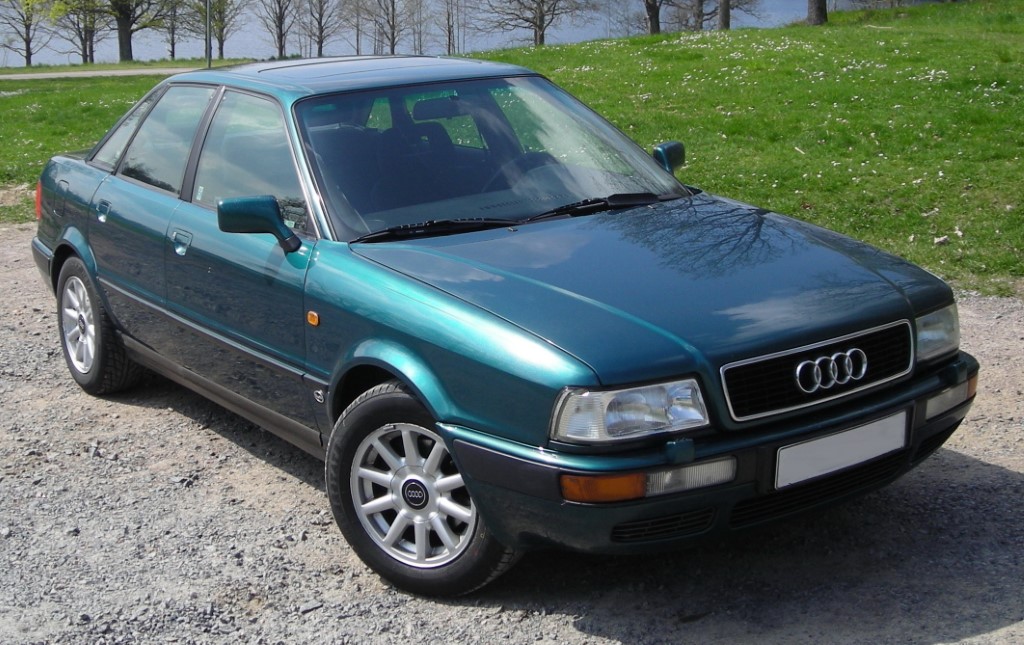 © Wikimedia.org/Mikael Wall, CC0
© Wikimedia.org/Mikael Wall, CC0
The Audi A1 (internally designated Typ 8X) is a supermini car launched by Audi at the 2010 Geneva Motor Show. Sales of the initial three-door A1 model started in Germany in August 2010, with the United Kingdom following in November 2010. A five-door version, called Sportback, was launched in November 2011, with sales starting in export markets during spring 2012. The A1 was previewed at the 2007 Tokyo Motor Show in the form of the Audi metroproject quattro concept car. The concept seats four and features a new plug-in hybrid powertrain. With this powertrain, a 1.4 L (85.4 cu in) 148 bhp (110.4 kW) Turbo FSI engine drives the front wheels via a six-speed S-Tronic, while a 40 bhp (29.8 kW; 40.6 PS) electric motor provides power to the rear wheels. The electric motor is also capable of producing 148 lb⋅ft (201 N⋅m) of torque. (Source: Wikipedia.org, CC BY-SA)
The Audi A2 (internally designated Typ 8Z) is a compact MPV-styled supermini car, with a five-door hatchback body style and four or five seats, produced by the German manufacturer Audi from November 1999 (for the 2000 model year) to August 2005. Based on the Audi Al2 concept car first shown at the Frankfurt Motor Show in 1997, the A2 was notable for being constructed from aluminium, which in combination with its efficient engines, made it an extremely economical car on fuel. Packages available in Germany included 'Advance', 'Style', 'High Tech', and later 'S line'; whereas in the United Kingdom, the A2 was available in various trim levels, including: 'Standard', 'SE' (for 'Special Equipment'), 'Sport', 'Special Edition' (2005 only). (Source: Wikipedia.org, CC BY-SA)
The Audi A3 is a subcompact executive/small family car (C-segment) manufactured and marketed by the German automaker Audi AG since September 1996, currently in its fourth generation. The first two generations of the Audi A3 were based on the Volkswagen Group A platform, while the third and fourth generations use the Volkswagen Group MQB platform. The original A3 (or Type 8L) was announced back in June 1995, but introduced first in the European market for more than year in September 1996, marking Audi's return to the production of smaller cars following the demise of the Audi 50 in 1978. This was the first Volkswagen Group model to use the 'PQ34' or 'A4' platform, bearing a close resemblance to the contemporary Volkswagen Golf Mk4, which arrived a year later. Within three years, this platform was used for total of seven cars. (Source: Wikipedia.org, CC BY-SA)
The Audi A4 is a line of luxury compact executive cars produced since 1994 by the German car manufacturer Audi, a subsidiary of the Volkswagen Group. The A4 has been built in five generations and is based on the Volkswagen Group B platform. The first generation A4 succeeded the Audi 80. The automaker's internal numbering treats the A4 as a continuation of the Audi 80 lineage, with the initial A4 designated as the B5-series, followed by the B6, B7, B8, and the B9. The B8 and B9 versions of the A4 are built on the Volkswagen Group MLB platform shared with several models and brands across the Volkswagen Group. The Audi A4 automobile layout consists of a front-engine design, with transaxle-type transmissions mounted at the rear of the engine. The cars are front-wheel drive, or on some models, 'quattro' all-wheel drive. The A4 is available as a sedan and station wagon. Historically, the second (B6) and third generations (B7) of the A4 also included a convertible version. For the fourth generation (B8) and onwards, the convertible, along with a new coupé and 5-door liftback variant, was spun-off by Audi into a new nameplate called the Audi A5. (Source: Wikipedia.org, CC BY-SA)
The Audi A5 is a series of compact executive coupe cars produced by the German automobile manufacturer Audi since June 2007. The A5 range additionally comprises the coupe, cabriolet, and 'Sportback' (a five-door liftback with a fastback roofline) version of the Audi A4 saloon and estate models. Under Audi's internal platform numbering convention, the A5 is a member of the B-platform series of vehicles, sharing its platform designation with the A4 saloon and Avant. The first generation A5 (Type 8T) is therefore a member of the B8 family, whilst the second generation model (Type 8W6) is based on the B9. Both are derived from the Volkswagen MLB (Modular Longitudinal Matrix) architecture. (Source: Wikipedia.org, CC BY-SA)
The Audi A6 is an executive car made by the German automaker Audi. Now in its fifth generation, the successor to the Audi 100 is manufactured in Neckarsulm, Germany, and is available in saloon and estate configurations, the latter marketed by Audi as the Avant. Audi's internal numbering treats the A6 as a continuation of the Audi 100 lineage, with the initial A6 designated as a member of the C4-series, followed by the C5, C6, C7, and the C8. The related Audi A7 is essentially a Sportback (liftback) version of the C7-series and C8-series A6 but is marketed under its own separate identity and model designation. All generations of the A6 have offered either front-wheel-drive or Torsen-based four-wheel-drive, marketed by Audi as their quattro system. The A6 has also been used as the basis for the company's Allroad models since 1999. (Source: Wikipedia.org, CC BY-SA)
The Audi A7 is an executive luxury five-door liftback coupé produced by Audi since 2010. Also available as a three-box, four-door saloon in China since 2021, it features a sloping roofline with a steeply raked rear window and integrated boot lid (forming the so-called 'Sportback'), and four frameless doors. The Audi Sportback concept is a concept vehicle powered by a 3.0-litre V6 TDI clean diesel engine rated at 225 PS (165 kW; 222 hp) and 550 N⋅m (406 lbf⋅ft) of torque. It features a 7-speed S tronic transmission, quattro permanent all-wheel-drive system, five-link front suspension, continuous damping control shock absorbers, electromechanical steering, ceramic brake discs (380 mm front and 356 mm rear), front 6-piston monobloc aluminium brake calipers, rear floating-caliper brakes and 21-inch wheels. (Source: Wikipedia.org, CC BY-SA)
The Audi A8 is a full-size luxury sedan manufactured and marketed by the German automaker Audi since 1994. Succeeding the Audi V8, and now in its fourth generation, the A8 has been offered with both front- or permanent all-wheel drive—and in short- and long-wheelbase variants. The first two generations employed the Volkswagen Group D platform, with the current generation deriving from the MLB platform. After the original model's 1994 release, Audi released the second generation in late 2002, the third in late 2009, and the fourth and current iteration in 2017. Noted as the first mass-market car with an aluminium chassis, all A8 models have used this construction method co-developed with Alcoa and marketed as the Audi Space Frame. A mechanically upgraded, high-performance version of the A8 debuted in 1996 as the Audi S8. Produced exclusively at Audi's Neckarsulm plant, the S8 is fitted standard with Audi's quattro all-wheel drive system. The S8 was only offered with a short-wheelbase for the first three generations, being joined by a long-wheelbase variant for the fourth generation. (Source: Wikipedia.org, CC BY-SA)

Time for recess! Post a comment, ask a question or write a review. Feel free to let us know what you think!
look at the sign on the road to avoid accidents and horrible driving conditions
I received a 300$ ticket because I passed a police control of other cars/drivers on the right lane of a highway (the control was on the hard shoulder of the highway). Is it really true, that you have to change the lane in such cases? Thanks!
I am an American living in Italy. The Italian Drivers License theory test is the hardest test I have ever studied for and I am in my 70s have multiple degrees, multiple professional certifications. Have to take the Italian Drivers Theory test in Italian. No english. So many rules. More signs in small medieval Italian town I live in then in major US cities I have lived in. No Italian license no driving. No buying or renting a car. Test here was good, clean. Lots of tricky questions on many practice and real official tests. Thanks
Most problems are a result of higher than safe driving speeds. Please just slow down and be patient.
Question 121: Poor translation: Vehicles with polluted fluids prohibited Should be translated as: Vehicles with dangerous liquids prohibited
Question 83: Poor translation: Vehicles with polluted fluids prohibited Should be translated as: Vehicles with dangerous liquids prohibited
Want even more practice? Visit similar websites offering realistic practice driving knowledge tests. Visit us to see what sets our tests apart! https://dkttest.com/capital-territory/
Cool tool! And fun to check whether I remember the rules :) Two things I noticed: Warning for a crossroad side roads on the left and right. While technically that might be the correct translation, this sign tells you, that you are on the main road and have the right of way for the next crossroad and only the next crossroad. Usually (if no sign specifies otherwise) you have to give way to drivers coming from the right at every intersection, which can get a bit annoying in communal areas, so seeing this sign feels less like a warning and more like relief :). A Fahrradstraße is not a lane for cyclists but a street for cyclists, meaning the (whole!) street is intended predominantly for cyclists, who are then allowed to ride next to each other. Cars are allowed to drive there (unless another sign prohibits such), but have to adjust their speed to the cyclists. I believe they are not allowed to pass at all, even if the oncoming lane is empty.
More community